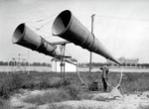At Audio Video Logic in Des Moines, IA, we are an authorized dealer for both the TAD product and the JBL Everest. After listening to both of these fine speakers for 60-90 days, I'm able to offer a mini review for those who follow very high end speakers.
TAD Reference One $70,000 pair. JBL Everest $60,000 pair.
Bass extension: Advantage TAD which hits 25hz flat even in a very large room.
The JBL is flat to around 32hz, a surprise based on it's spec to 45hz.
The difference here isn't meaningful on most music.
Bass linearity: Advantage TAD which avoids a upper bass emphasis the Everest
appears to have built into it between 100 and 200hz. This bump slightly obscures the octaves below and is the Everest's single biggest short coming.
Bass slam: Advantage JBL. Not many speakers can compete with the Everest and the
TAD is no exception, but it is by no means weak.
Bass definition: Closer here and is set up and pretty amplifier dependent. The JBL wins if you can place the speaker to minimize the 100-200hz bump.
Large scale dynamics: Advantage JBL by quite a margin. Again the TAD is better than most audiophile speakers and is no weak sister.
Driver integration: The TAD wins hands down. With it's concentric midrange/treble driver no other speaker I have heard competes here. It sounds like a one way speaker with out all of the problems one would have. There is some sense of discontinuity
between the JBL woofers and the midrange horn/driver when compared to the TAD's.
Stereo imaging: The TAD images and focuses like a mini monitor but with a huge scale to the sound. The JBL has a huge sound as well but considerably less focused.
Overall clarity and naturalness in midrange and treble: Pretty close here. Better micro detail with the TAD, better sense of ease with the JBL.
Overall smoothness in midrange and treble: Advantage TAD. Since it measures
better than any speaker I've ever tested, JBL should be proud of honorable mention here.
The main demerit is a 4db peak or so around 16khz that is probably the midrange
compression driver break up frequency. Never the less, excellent measurements for a horn speaker.
Treble extension. Both measure flat to 20khz and beyond and sound effortless and very extended.
Overall tonal balance. TAD is octave to octave flatter. The JBL has more of a front row presentation, but not too forward sounding unless the recording is poor.
Equipment sensitivity: Both highlight weakness's of components down stream. Despite their high sensitivity and reasonable impedance curve, the JBL's are more amplifier sensitive than you would think particularly in regards to bass control. The TAD's can sound thin with the wrong power amp.
In a review where they total points by category, the TAD would win. But the JBL has more of that elusive "you are there quality" which shows that you can't assign equal points to each category. Most non audiophiles who compare the two pick the JBL. Most audiophiles pick the TAD because of it's imaging but are surprised by how good the JBL is.



 Reply With Quote
Reply With Quote






 .
. 



